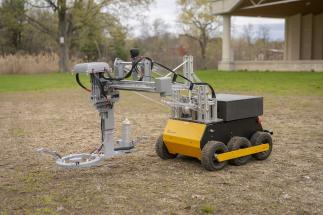Students at Worcester Polytechnic Institute (WPI) are developing an autonomous rover and payload-deploying drone that work together to search for and detonate landmines, a multi-year effort to provide a safer and more cost-effective way to remove a deadly threat to people around the world.
Each year, landmines planted during wartime across fields and backyards and around critical water sources kill or maim an estimated 15,000 to 20,000 people worldwide—one in five of them children—according to UNICEF. Local citizens, unable to afford massive mine detonating machines, use ineffective and dangerous methods to detect the landmines, from slowly poking the ground around them with long sticks to training large, leashed rats to sniff out explosives.
“Landmines are a huge issue worldwide,” said Craig Putnam, senior instructor of computer science at WPI. “They are laid during wars, but long after those conflicts end, the mines continue to kill and injure people. Mines can stay active, and deadly, for up to five decades, so finding and clearing them is critical.”
Under Putnam’s guidance, a series of student teams working over the past three years have developed the dual-function robotics system: the autonomous rover to detect and and mark the mines and the drone that can drop payloads onto the mines to safely detonate them. A new MQP team has taken up the project again this fall.
Anti-personnel landmines, which are designed to be set off by the weight of a simple footstep, cause traumatic injuries, often destroying one or more limbs and causing burns, blindness, or other lifelong injuries, according to the International Campaign to Ban Landmines.
The militaries of large governments, such as those of the United States, have large, reinforced tanks or bulldozers with large drums and chains that can destroy landmines, but they generally are too expensive for smaller communities to purchase. Researchers around the world are working on new methods of detection, but the challenge is making the technology work outside the lab while also making it affordable for small communities.
This robotics system being developed at WPI, according to Putnam, could be an effective but more affordable option for land owners, towns, and villages.


